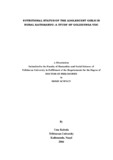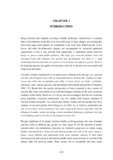Please use this identifier to cite or link to this item:
https://elibrary.tucl.edu.np/handle/123456789/1987| Title: | Nutritional Status of the Adolescent Girls in Rural Kathmandu: A Study of Goldhunga Vdc |
| Authors: | Koirala, Uma |
| Keywords: | Nutritional;Adolescent girls;Rural Kathmandu |
| Issue Date: | 2066 |
| Publisher: | Tribhuvan University Kathmandu, Nepal, Home Science Department |
| Abstract: | Proper nutrition is very essential for adolescent girls to improve the quality of not only their life but also the life of future generation as well. Despite the importance of this crucial period of life, there is little information on adolescent girl’s nutritional status. So, realizing this gap researcher tried to assess nutritional status of the adolescent girls of rural setting as a part of the study with the objective to examine the nutritional status of adolescent girls and identify the determining factors. The study was done in Goldhunga VDC with total sample size of 254 married and unmarried adolescent girls of age 12-19 years selected by the convenient sampling approach. This study used both quantitative and qualitative methods of data collection. The study found that the Brahmin is the predominant caste with 76.8 percent. Most of the families have nuclear setting with similar type of economic condition – low cash money with some agricultural production to sustain life. In total, 73.6 percent adolescents were found going to school currently. According to the study, mean age of starting menstruation is 13.7 and mean age of marriage is 15.7 years of the girls. In total, 22.4 percent (38.3 percent among the age 15 – 19 years) were already entered into the motherhood in which 30 percent were enjoying motherhood and rests were pregnant. Present study finding showed poor nutritional status in the form of stunted growth that is common among girls. The mean height of respondents fall below -2 SD NCHS reference height-for-age standard and are categorized as high risk of malnutrition. These girls are identified as more risk for reproduction because of short stature. Weight seems better in comparison of height. Mean weight of all respondents fall between -1SD and – 2 SD of NCHS reference weight-for-age categories. Prevalence of thinness (sever, moderate and mild) was also found high (48.5 percent) in Goldhunga village. Nearly 50 percent adolescents were suffering from anemia. The statistical analysis showed positive relation (sig. p <0.001) of height with social determinants such as age, family size, schooling, morbidity pattern, diet, menstruation status working hour, marital status and weight of the adolescents Most of the respondents were doing multiple but more labor intensive works like cloth washing, cooking, water carry, housecleaning, agricultural activities, carry of manure and fodder collection as regular activities. The average working hour of the girls is 7. Exposure of adolescent girls to developmental work is very low in Goldhunga. Study found that 17. 3 of adolescent girls was members of the group / club, 5.9 percent were members of the organization and only 8.3 percent of the total respondents had taken training of sewing, computer, teacher’s training. Eighty percent girls have no excess of mobility outside school. The civil societies working in the village are not utilizing the vi strength of adolescent girls in development work of the community. Wastage of this strength has made girls more reluctant about the surrounding in one side and is falling under the same traditional cycle of early marriage, reproduction, work burden, malnutrition and increased morbidity. Radio is one of the popular media and 76.4 percent of the respondents used to listen it. Sathisanga man ka kura is citied as a popular program listened by girls grippingly. In Goldhunga, 78 percent girls' family owned television and 55 percent girls read newspaper / magazine. However more girls are deprived of utilizing these media properly because of scarcity of time due to heavy work burden. About the pregnancy and motherhood, 84 percent (among the married girls) had prolonged (12 or more hour) labor period, 52.3 percent delivered their child in hospital / nursing home but 47.7 percent gave birth at home. Among the married girls, 52.3 percent had one child where as 47.7 percent had 2 children. Five percent babies were born preterm. Nearly 78 percent pregnant / lactating adolescent girls did not eat extra food during pregnancy or lactation. Based on this study results it is comfortable enough to point out that the nutritional status of the adolescent girls is not adequate and are falling into the same intra generational cycle of malnutrition. Proper intervention program to channelize this potential group is an urgent need so that they can groom well to guide and lead a healthy and happy life which is the fate of the nation as well. Based on these observations the study has made some recommendation as well. One among the various recommendations – a wide range of dissemination of this research is suggested to draw attention about the issue of adolescent which are mostly rested in the shadow. Consultation with the local community is also important to make realization about the situation of their grown – up child and their requirements. |
| URI: | http://elibrary.tucl.edu.np/handle/123456789/1987 |
| Appears in Collections: | Political Science |
Files in This Item:
| File | Description | Size | Format | |
|---|---|---|---|---|
| Cover Page 4204.pdf | 176.6 kB | Adobe PDF |  View/Open | |
| 4204 final.pdf | 1.35 MB | Adobe PDF |  View/Open |
Items in DSpace are protected by copyright, with all rights reserved, unless otherwise indicated.
